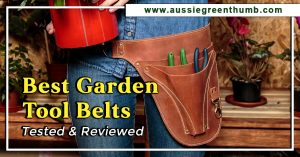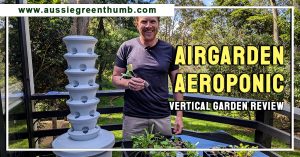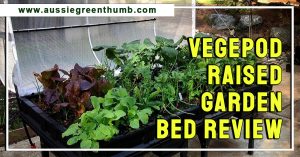If you're someone who wants to grow your own vegetables but you always manage killing them or their not being as fruitful, luscious or as juicy as you would want, then maybe the Airgarden is what you need.
Consider the possibility of growing your own vegetables, enough to feed you and your family in a space of only half a square metre.
Prue and Tom, the founders of Airgarden, have used the same science that NASA uses to grow vegetables in outer space to create the Airgarden using aeroponics.
Grow your plants 3x Faster and use 95% less water then growing in soil.
Watch the video, or read the transcript below, to see how the Airgarden and aeroponics can change your growing experience and your life.
Hear the exciting new way to grow up to 30 plants at once, in a small space, which only takes 5 minutes of your time per week.
Nathan Schwartz:
Hey everyone, Nathan from Aussie Green Thumb here and today we are joined by a couple of special guests. They have designed a gardening system that uses aeroponics to help grow plants three times faster and use 95% less water than soil. Prue and Tom, the founders of Airgarden, great to have you both here today.
More...

Source: airgarden.com.au
Prue:
Thanks for having us, Nathan.
Tom:
Thanks, Nathan.
Nathan:
Now, most of our audience know about traditional gardening and even hydroponics but not many people have heard about aeroponics. Would you guys like to give us an overview of what it is?


Get Your Free Guide:
Master Growing Australian Natives eBook
A Must Have Complete Guide for Every Australian Garden
Get Your Free Guide:
Master Growing Australian Natives eBook
A Must Have Complete Guide for Every Australian Garden
Prue:
Yeah, definitely. I think it's reasonable. Everyone seems to know about hydroponics but aeroponics is a little bit of I guess the new kid on the block so people are starting to learn about it slowly but surely.
It is closely related to hydroponics, the key difference between the two is with... or the easiest way to think of it I guess is with hydroponics, the roots of your plants are consistently underwater, and with aeroponics we're just using the air and the water but the plants are suspended in the air and they are getting water intermittently.
So they are getting very, very high levels of oxygenation so it's predominantly growing with air and water but no submerging of the roots under the water, so they're in the air.
Tom:
Yeah, for an extended period of time, because even with some hydroponics there are what's called flood and drain systems and things like that, but yeah, the other key difference with ours as well is obviously a lot of traditional hydro systems too are horizontal, horizontally set up, whereas ours is vertical as well Nathan.
So the other big distinct difference with our difference as well, it takes up a very, very limited amount of space because we're going up. 30 plants in less than probably half a square meter.
Nathan:
Right. Talk about using the air room well.
Tom:
Yes.
Nathan:
So how have you implemented aeroponics in the Airgarden? How does the Airgarden work?
Tom:
Well it's basically the heart and soul of the system, Nathan. It's based around that principle of aeroponics, we've designed the Airgarden to have a fairly large reservoir of water at the bottom of it. Contains around 85 liters of water.
In that water, as you mentioned before, there's no soil at all. So we use a coconut coir growing plug or medium just to start our seeds. They sit in a net pot above that reservoir of water.
Tom:
We've got a submersible pump in the base of the reservoir and as Prue was saying, it's on a periodic timer, so it will draw water up into the top of the system and the system's designed as such where there's strategic holes placed all through it to shower each of those 30 plants that we've got sitting up in the system.
And by sitting up vertically and in our little net pots, we take advantage of that cycle of that water, that nutrient rich water hitting those plants and then it's staying off for a fair period of time so we've just got complete roots sitting up in air, basically, a lot of oxygenation coming in and around those roots.
That really helps those plants absorb nutrients and take in more nutrients and do more with it. Even compared to hydroponics it's quicker. So that's really it in a nutshell, if that makes sense mate.
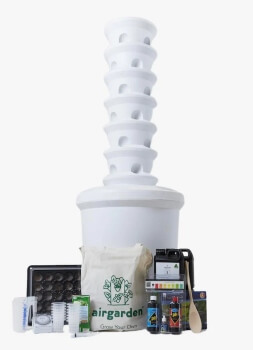
Source: airgarden.com.au
Nathan:
Yeah, it does.
Tom:
Good.
Nathan:
So because of all the air the plants are able to absorb the nutrients more?
Tom:
Yeah. Basically it just allows... there's more surface area. You've got more surface area of those roots exposed to that nutrient solution. It allows for more of an exchange and a quicker and bigger uptake of the nutrient that you are feeding that plant, as opposed to having it completely submerged all the time in water or completely submerged intermittently in a pool of water.
Tom:
So we're not scientists by any way, shape or form. Aeroponics is a technology that Prue has probably mentioned, it was developed by NASA to feed scientists or astronauts in space. Obviously you can't take big soil based gardens up in the middle of space.
So it's something developed years ago. A lot of them use really high pressure aeroponics so kind of misting style stuff, but it's the exact same principle, lower pressure, same result. Just a lot easier for the novice gardener, and Prue and I certainly were when we undertook this whole thing. We had a lot of failure growing stuff out of soil.
We saw this as an opportunity, we were like there's got to be a better way to do things, got to be an easier way to do it, we're all time poor, my sister's got two crazy kids. So that's basically how it all came about.
Prue:
I think the other thing also is 1 in 10 Australians now don't have a yard, right? They're living in an apartment or a unit or the great Australian dream with the big backyard isn't something that everyone's doing these days. So it's also well, how can everyone do this regardless of where they live?
Tom:
And there's a lot of renters as well and a lot of young people. A lot of young people now aspire to healthy eating, they want to grow their own fruit and veg and you think, you're a renter and you're in an apartment or even if you're a renter with a house, if you've got a big soil based kind of garden you can't take that with you if you lease out.
So the beauty of our system is it literally packs down into the reservoir where all the parts are nesting, there's no tools involved, it's all snap fit together, and we really think it's a great solution to-
Prue:
Yeah, you just pick it up and take it with you when you move.
Tom:
Take it with you, yeah. It's really easy.
Nathan:
Okay, so what does it weigh, about 10 kilos? For an Airgarden. When there's no water in it.
Tom:
Empty? When there's no water in it? Probably, yeah, probably around about that I'd say. Yeah, about 10, 15 kilos. So it's really light. Literally got some wheels, you've got built in wheels at the bottom.
Prue:
You can push it around.
Tom:
You can push it around even once you've got it and you want to move it because the other thing too with soil based gardening is it's only in the one spot, right? So seasons change, summer, winter, the sun actually moves in the sky.
The great thing about the Airgarden is you can kind of adapt it, you can move it to your environment. If you get really... we get some really crazy summer storms coming through Brisbane, to be able to move your Airgarden or your whole garden in and away from, you know-
Prue:
Hail, storms.
Tom:
... hail, storms, all that stuff, is pretty cool as well. We've done a lot of thinking and put a lot of effort into thinking about all these kind of things that we would want in this product, to make stuff really easy and adaptable and just kind of second nature to people.
Prue:
I think that's one of the key drivers behind Airgarden and the brand is that it is easy and anyone can do it anywhere at any time. And that's something that is constantly, whenever we're doing anything or looking at the design or looking at what we might add on, it's, does it make the end user's life easier?
Nathan:
So how long... So you've got your 30 plants you've had growing. How much time a week does it take to look after?
Prue:
Five minutes.
Tom:
Five minutes. It's really, really simple Nathan. With our new Airgarden, when you first put your plants in when they're seedling size, when they're this big, you can literally fill your reservoir up, you fill your reservoir up, you put your two part nutrient in, you balance your pH, that's it.
Plug it in, you've got it in on the timer, and literally you don't have to fill that reservoir up for probably around three weeks, initially.
Tom:
And really, we say the only thing now coming into spring and stuff, you've just got to keep an eye out for bugs and stuff, really. And you want to just make sure you're maximizing your sun and aside from that, you just kick back mate and let it do all the hard work for you, essentially.
Prue:
And that really, like we set six up at my son's school just before the school holidays and literally no one has looked at them. I went up yesterday, it was the start of school term on Tuesday here in Queensland, and hadn't touched them.
The plants were enormous, like I've got to go back and harvest all the lettuce off them, but they hadn't been touched in three weeks. No one has touched those Airgardens since we set them up three weeks ago and they are booming.
Tom:
They're going crazy. And for a lot of your viewers and subscribers out there, if they want to see it in action, you can go to our website, airgarden.com.au or we've got a YouTube page, a YouTube channel as well. And there's some 21 day time lapses of the Airgarden going from-
Prue:
The speed of growth.
Tom:
... that seedling. And you'll see how fast it is. Literally within 21 days you can start harvesting those leafy greens, those lettuces and those herbs and things like that.
Prue:
And less in summer, it's almost two weeks.
Tom:
It's pretty crazy. You can start trimming and picking and getting your food. But yeah, in that first period it really is fairly hands-off, very hands-off. Then moving forward, it's probably literally five minutes a week.
It's nothing. It really is. And the one thing you have to kind of remind people is it grows so fast, it looks so beautiful and so amazing, people don't want to touch it because it looks so good.
Nathan:
It looks like a masterpiece.
Tom:
Yeah, you've got this masterpiece and it looks so great, people are like, "Oh my god, I don't want to touch it, it looks perfect." But in actuality, by trimming and harvesting plants it really helps them grow. It takes away kind of... You're trimming diseased plants away, the diseased leaves away.
It actually really helps plants and stimulates them and really helps them grow even more. So that's really it. The time that you do spend is just keeping an eye out for pests and then after that three week mark you're ready to start harvesting things and using it.
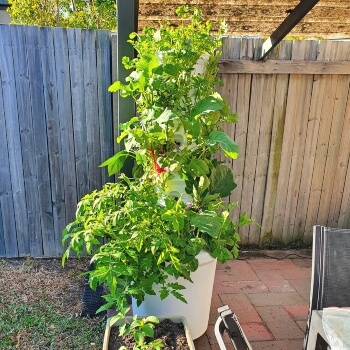
Source: airgarden.com.au
Prue:
And you're just topping up water and adding nutrients. It's really simple.
Nathan:
It does sound quite simple. So with the nutrients that you top in there, I notice that you've got the one liter pack that comes with the Airgarden. So you just use that same pack of nutrients for anything you plant in there?
Prue:
Yes.
(Setting Up Your Airgarden)
Tom:
It's a one size fits all Nathan. So it's a two part nutrient solution. So when you first fill up your Airgarden, you're always adding nutrients in equal parts, so it's really easy. You're never going, "Oh, this time I've got to add 100 mil of this and 300 mil of that."
No, it's really simple.
You add 200 mil of your part one when you first fill up your reservoir, you add 200 mil of your part two, you just do it separately. Give each of them a stir and then that will naturally bring down, that's got some pH buffers in it.
Because with your plants, they need to have a pH running to around five and a half to six and a half for those plants to be able to take all of that nutrient out of the water and absorb it and grow. So that's that magic range.
Tom:
But you add your nutrient solution in, that'll naturally drag down the pH of your tap water. Your pH of your tap water usually starts at around seven and a half to eight, depending on where you are. So that just naturally brings it down and then you get a really concentrated pH kit with the Airgarden.
So everything you need to start growing is included with the Airgarden. That's the really good thing about it. You don't need to go get bags of soil or any of that kind of stuff, we give it all to you.
A couple of mils of your pH down, you're right as rain, you're good to go, and then you really don't need to do that nutrient thing again.
Tom:
What we say to people usually is you let your water drop down in your reservoir to halfway. That can take, as we said initially when your plants are small, that can take around three weeks. So you're not doing much.
Once your plants start getting a little bit bigger and you've got some fruiting plants in there, because you can grow 150 different types of fruit, veg and leafy greens, herbs and all that stuff.
So when you've got tomatoes and cucumbers and things like that, they're a bit more thirsty.
It's really easy that second time that your water goes down:
- You just top it up with some water, some plain water.
- You just add a little bit of your part one and two nutrient solution.
- You kind of repeat that process that you did when you first set it up.
- So it really is simple and it's just getting your head around that process.
Prue:
Whilst it sounds complicated there and all those measurements, you've got four things you've got to do every week. You check your water, you balance your pH, you harvest your food and you make sure you haven't got any pests or leaf disease. That's it.
Tom:
It's really easy.
Nathan:
Pretty simple, it sounds.
Prue:
Yeah, very simple.
Tom:
Super simple, yeah.
Prue:
And I think the other thing too, people are getting results really quickly, which is encouraging them to keep going with it and I think that was one of the other things that we really wanted to conquer is that people got that early success when they were trying to grow their own food so that they would continue to do so, as opposed to that inconsistent result that people often get when you're doing traditional gardening.
Nathan:
When you're waiting for weeks for something to germinate and then you're not sure if it's a weed or if it's the actual plant. So you wait a bit longer and you realize it was a weed and you're like, should have restarted earlier.
Prue:
That's exactly right.
Tom:
And it's hard sometimes, too, Nathan. What we found, like with soil based stuff, sometimes you don't know what lever to pull if you're not getting success. Because if you don't have the tools to measure what's the pH of the soil and all this kind of stuff.
Prue:
The potassium or the zinc.
Tom:
You don't know. There's so many X factors with soil. Whereas with us we're saying, "You're putting your nutrient in and you're doing your pH and if you're checking your pH and it's within this range, well okay there's only X, Y, and Z, there's only probably the pests and maybe the nutrient solution needs to be completely emptied and changed over."
So you kind of pull levers really quickly if you're noticing some issues, like oh my leaves are yellowing or something's going on. You can kind of pull a lever pretty quickly to get things back on track, if that makes sense.
Nathan:
Yeah, it does. I think the troubleshooting makes it a lot easier when you've got water and nutrients and sun and that's it, there's no what else is in the soil, what else is here?
Tom:
Absolutely, yeah. And that's a really, really good point you actually just brought up there, mate. The only other X factor is sun. I mean, we get some people and god bless them, they're like, "Things don't seem to be working." "Oh, where have you got the Airgarden," we say.
And they go, "Oh, it's under my veranda and it gets one and a half hours worth of sun a day." And we're like, "Well, you need a minimum... These are living plants, you're growing plants, so the real X factor is you need a minimum of four hours sun and sun is that-"
Prue:
Direct sunlight.
Tom:
Direct sunlight, direct sun meaning not kind of just outside but you can literally see that sun beaming down and hitting the Airgarden.
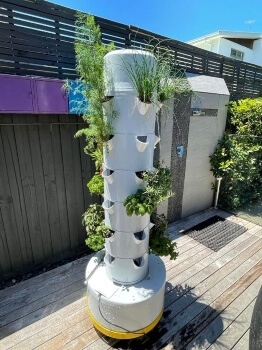
Source: airgarden.com.au
Prue:
I think the other part too, is that not all people do have access to that.
Tom:
That's right.
Prue:
So later, or toward the end of this year which we're nearly in, God help us, but there is an LED grow cage that will be available with the Airgarden as well. So if you only have the option of growing indoors, then you can still grow. Which is quite helpful for people as well.
Nathan:
Yeah. It sounds like it will really open up the market for everyone, no matter where you are then.
Prue:
Yeah. Which is exciting.
Nathan:
So what's the Airgarden made out of?
Tom:
Yeah, Airgarden is made out of, and we're really proud of this fact, Nathan. But we're doing all our research and stuff, and when we first started this a lot of... there were a few different products available overseas, Europe and the United States.
We were very, very, very committed to making the Airgarden locally. We're the only Australian made product like this out there in the market and we're really, really proud of that fact. The Airgarden's made out of UV stabilized food grade plastic.
So that UV stabilized plastic is really important and that food grade plastic is really important to Australian standards, because like everyone, my sister has got a couple of little kids, we're very cognizant of we're growing food for ourselves that we're going to be ingesting into our bodies.
Tom:
We want to make sure that what we're making this out of is completely above board and ticks all of those boxes in terms of safety, efficacy, longevity with the lifetime warranties on all of our componentry as well.
The other really great thing about our Airgarden as well is at the end of its life, it can be sent back and it can be recycled and upcycled into another product. It's never going to end up in landfill.
Prue:
It's not single use.
Tom:
It's not single use plastic.
Prue:
Which I think is important to point out to lots of people. Because some people go, "Why don't you make it from something else?" But it's really the only material that gives us the utility and the functionality for this system to be able to do everything that it can do.
But the good part about that is, as Tom said, it's never going to end up in landfill because we can take it back and recycle it with our manufacturers.
Nathan:
So you said at the end of its life, how long would that be? Because it's sitting in the sun all the time, it's UV protected. You guys haven't come across this yet, it's not long enough in the market to test it?
Tom:
It hasn't been long enough to be honest. But just to give you an idea, Nathan, the UV stabilizers in our system, it's the same stuff they use for water tanks, so residential water tanks.
That's, you know, 10, 15 year kind of stuff in terms of that type of longevity. So we're not talking about just a couple years.
Prue:
Yeah, it's fairly significant.
Tom:
It's, God, I mean 5, 10. It's a l ong time.
Prue:
Well, we've had our original ones, if you think about it now, for five years. And they're still going. They're absolutely fine, they look the same as the day we got them except maybe a few more scratches and bumps from children and dogs.
Tom:
And from a few footies, random footballs and bikes banging into them. But the amazing thing too about that, Nathan, this is a really important point, because I think we all have something that you’ve got from Bunnings.
You've bought a plastic product, an outdoor product, and what happens, it gets brittle over time. It yellows. As Prue was just alluding to, our original Airgardens that we still have that are now five years old, no yellowing, no brittleness, nothing like that.
They're purpose built, they're made to be outside.
They're made to... And some people go, "Oh what if it rains?" No, they're meant to be outside. They're rough, tough, they're purpose built for being out in the elements seven days a week, 365 days a year.
Nathan:
Oh, perfect. So what's your story? How did the Airgarden come about?
Prue:
A big couple of reasons, Nathan. One, obviously the multiple failed attempts at trying to grow our own food. And I think the other big one for Tom and I were just really, I guess thinking that our current food system's pretty broken and not potentially operating as well as it could be.
And also wanting to, I guess, have something that was good for people but also the planet as well. So there are a couple of things, really, I guess driving us there, health, nutrition, environment, and frustration at not being able to consistently grow our own food and having to buy things at the supermarket that would be slimy or go off within just a couple of days, massive food waste, there was no flavor.
Prue:
It just didn't seem like it was a good solution for long-term. That's kind of how the Airgarden came about. We were like, well there's got to be an easier way to do this, a better way to do it. It's got to be simpler but it's also got to be good for people and the planet.
So that's how Airgarden came about. Then we figured out what we wanted to do but then we were like, oh, how are we going to make this now? We've drawn it and we know what it's supposed to look like but now what do we do?
We don't want to manufacture offshore, we want it to be Australian made, we don't want to import. So we partnered with the Evolve Group, who are here in Crestmead in Brisbane, which was lucky for us.
And we've been working with them to develop and continue to, I guess, iterate on the Airgarden design since the end of 2017. So yeah, it's been... I said to Tom, "Look, we're half a decade on," the other day.
Tom:
Couldn't believe it.
Prue:
And Tom's like, "Oh my god, has it been that long?" I was like, "Yeah."
Tom:
Completely down the rabbit hole. But yeah, we wanted it to... As Prue was saying, we looked and there were things that were around. We didn't want to import something and we looked at that and we were like, by the time we import this, there was a couple of things.
There was one, all those environmental goals go out the window because you're like all right, we're importing a product thousands of miles across the ocean but we're talking about food miles.
So that's a bit disingenuous. And there was also an issue of cost. We would have had to sell something like that for probably a pretty unaffordable amount of money.
Prue:
Transparency into the product and the raw materials that were being used, which is very difficult when it's not-
Tom:
It's difficult when it's not made locally. And the other real thing about that is, talking about affordability around it and what it is, the price of the Airgarden is $799, including GST.
And we think that is amazing value for money considering... We were sitting down the other day and we went, "Oh my god, someone will go and buy a flat screen TV for $2500.
You know, you buy that for $2500 and then what does that give you back really? I mean, aside, it might save you from going to the movies a couple days a week but people will go and buy a barbecue, a $1200 barbecue, an amazing big thing. Will buy a couch, will buy whatever.
Tom:
The beauty about the Airgarden is it starts putting money back into your pocket the minute you buy it. And if you're really conservative, and it's like everything, you've got to put a tiny amount of effort in.
You put a really tiny amount of effort in and you'll get some back, and the Airgarden will conservatively grow you, if you're really just putting a small amount of effort forward, it can grow you $1000 worth of produce in 12 months.
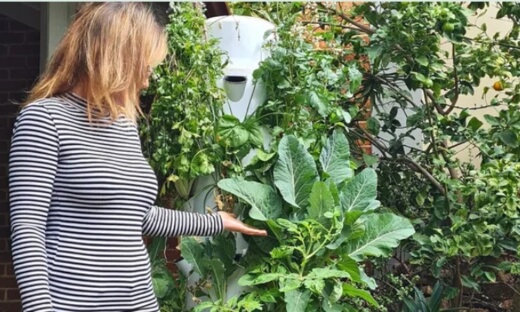
Source: airgarden.com.au
Prue:
That's conservative.
Tom:
That's pretty conservative and that's... There's nothing we can think of really that's got a payback period that quickly that you buy for your house and that actually gives you so much back in terms of-
Prue:
Well, it feeds you for life. That's the other thing.
Tom:
Your food, your health and all that stuff. And it really brings you joy as well.
Prue:
Massively reduces the food wastage in your household, but I think it is a little bit of a movement for us in the sense that using a system like the Airgarden takes a massive load off our natural resources. Like, we're recycling water, we're reducing food waste, we're only taking what we need when we need it.
So if every household, even a percentage, 1% of households in Australia, like it makes a difference because food waster is one of the biggest contributors to the CO2 and also to a user of water, like the production of food is massive.
Tom:
It's crazy. When you look at the numbers it really makes your head spin. You look at lettuce is such a staple, we all eat it, we all love it. It's what we eat. It's the first thing we eat when we think of leafy greens.
And to make a field of lettuce is around 50 liters of water for one head of lettuce. We use about four liters.
Prue:
It's a massive difference.
Tom:
It's a huge difference. Australia's one of the driest places on earth, even though we're third year of La Niña, we need to remember in our heads that Australia's a place of boom and bust, and more times rather than not we're short of water in the country and water security is a really big thing moving forward with climate change and all those kind of things. It's a really big consideration that we all need to think about.
Nathan:
And I think even having, like being able to grow your own thing with the supply chains or what's going on with the farmers.
Tom:
Oh, massive.
Nathan:
In Sydney, lettuce is $12 each. So that's sort of big. Plus the water usage and the travel costs to get the lettuce into the stores. There's a lot of savings to be made.
Tom:
Massively, yeah.
Prue:
And the other side to that is, it's that old saying, let food be thy medicine. But realistically, most of the food that we eat has got zero nutritional value because spinach is a great example. Four hours after you've harvested it it's lost 50% of its nutritional value.
The great thing about the Airgarden is that you're straight from the garden to your mouth when you want it. And I had a chef here from New York at my place and he was looking at the Airgarden and just thought it was amazing. And he said, "I just can't get over this produce."
Tom:
The flavor of it.
Prue:
Flavor, but there's also juice and moisture in the plants. He said, "By the time we get stuff in the kitchens it's just so depleted and nutrient dead and the flavor is hard to come by." So I think there's all those things too that people forget about.
We do have so many health issues as well, like around the world, that you can relate back to food and diet. So it plays... Being able to have that right at your fingertips I think is also really important.
Tom:
Yeah. It's pretty cool. And once you get used to it as well, you're like oh my god, this is what rocket is supposed to taste like.
Prue:
Yeah. So peppery.
Tom:
It's supposed to knock your socks off, like oh my god, that's crazy. My shallots really have that intense flavor. And the other really cool thing as well is there's all that lofty stuff, environmental whatever, but taste, but even just growing, it's amazing when you're growing something from a seedling to a plant you just get this real excitement and kinda stoke about it.
"Oh my god, I've grown this little thing. Look at it." It's really awesome. It really kind of pumps your tires up, it gets you really pumped up. It's kind of addictive seeing that grow from that to that, is really, really cool.
Nathan:
I can imagine growing snow peas where you'll go, "I can't find anymore." You come back the next day and there's like another five, and you're like, "They weren't here yesterday. Where did they come from?"
Tom:
There was a video recently of a lady and she thought she was getting these like pests were coming or possums were coming to steal her snow peas.
Prue:
It was the dog.
Tom:
And she had this super smart kelpie, and it was coming up and just taking these snow peas.
Prue:
Off the Airgarden.
Tom:
And my dogs don't eat snow peas, but it's like oh how good, they must taste epic if the dog is eating snow peas. That's pretty cool.
Prue:
Well, I kept blaming the possums at one stage for taking stuff off mine, and then I busted my son eating little raw dwarf cauliflowers and all the snow peas. He was just eating them off the Airgarden.
Tom:
Keep going, mate. Yeah.
Nathan:
That's what you want, when your kids are sneaking around eating veggies.

Source: airgarden.com.au
Tom:
Yeah.
Prue:
One was eating biscuits, one was eating the vegetables. So I was like okay, one out of two is not bad, I'll keep working on the four year old.
Tom:
It balances out, yeah.
Nathan:
So what's the best way for people to find more information and purchase an Airgarden?
Prue:
Definitely head towards the website, I think Nathan, there's a heap of information on there, lots of resources, which is www.airgarden.com.au.
Tom:
And that's really good as well, as Prue was saying down there, Nathan, you've got our links to our YouTube channel and that's really an awesome resource for someone who might just be trying to get their head around how does this thing work, I kind of get it but there's some really great videos that go through everything from growing a seedling, to setting things up, to adding nutrient.
It runs you through everything. So it's a really great resource of giving you a really great overview of what the Airgarden is and how it works on a day-to-day and how you interact with it.
Prue:
The other great resource is our Facebook growers group, which is... it's not input from us but you're getting real people's experiences and that's grown pretty rapidly. 600, 700 odd people, but really contributing. It's amazing, I try to jump in every couple of days and just see what's happening, what people are doing.
But it's amazing to see what people are doing and achieving with their Airgardens and that real community feel where people are helping and encouraging each other as well. So yeah, it's a great resource.
Tom:
Yeah. We're really proud of that.
Nathan:
And you guys ship Australia wide, I assume?
Prue:
Yes.
Tom:
Absolutely, mate. Yeah.
Prue:
We're in sunny Brisny land but yeah, Airgardens all across Australia.
Tom:
And remote too. Like we've gone to...
Prue:
Darwin.
Tom:
Broome, back of Bourke , mate, yeah.
Tom:
Yeah. Everywhere under the sun, mate.
Prue:
Mildura.
Tom:
Mildura. We've got it throughout now Kings Canyon Resort, which is south of Alice. So yeah. All over the place, mate.
Nathan:
Prue was telling me the other day that someone's got one on the yacht.
Prue:
Oh yeah.
Tom:
Yeah, it's pretty cool.
Prue:
Actually they're about to dock. They text me so I've got to touch... They want to come down and give us dinner on the boat from the Airgarden.
Tom:
Oh, nice.
Nathan:
Perfect.
Tom:
A couple of weeks up at the Whitsunday they've been, so yeah. That's pretty cool.
Nathan:
So Prue and Tom, it's been great hearing your story and learning about aeroponics and the Airgarden. Thank you so much for joining us today, it's been really wonderful chatting with you.
Prue:
Well, thanks for having us Nathan.
Tom:
Thanks very much, mate.
Nathan:
So I've just got one last question. If you could only grow one plant what would you grow and why?
Prue:
I'd grow rocket because I just eat so much of it and I love the flavor of it and the taste. I love it. I'm rocket.
Tom:
Rocket, I was going to say.
Prue:
One. You can only have one.
Tom:
Okay, rocket, yeah. You don't have to add onion to a salad, you don't need to add anything, you don't need to add vinaigrette or anything. You literally just eat it and go oh okay, actually, yeah, I had a meat pie and a lamington for breakfast.
This rocket can just offset all of that, mate. And mate, it's good. You just get back into the good graces. It's rocket for me too. And it grows quick, as well.
Prue:
Oh, so fast.
Tom:
You can just cut it, come again, mate.
Prue:
It just keeps growing, keeps giving.
Nathan:
All right, so everyone who gets an Airgarden, just grow rocket. Make sure you've got your rocket stash in there.
Prue:
Or jalapeno.
Tom:
Jalapenos. How long did Susan? have her rocket down at the coast, like four months?
Prue:
Six. It's longer. One of our clients and we were like, "You want to change that over?" She's like, "No, I'll just keep growing." I'm like, "Are you sure? It's not bitter?" For four months.
Tom:
It was going to flower, she just cut the flower off and then she'd just keep... And I'm going, "Does that taste..." And it still tastes great.
Prue:
So good.
Tom:
So, mate, the answer is rocket.
Nathan:
Rocket, okay, perfect.
Tom:
Yeah. That's it.
Prue:
Oh god, we just keep talking.
Nathan:
Well, we're going to stop the interview there. Thank you so much, guys. As I said, it's been wonderful.
Prue:
Oh, no worries mate.
Nathan:
And we'll be looking forward to having you back on shortly.
Prue:
Thank you.
Tom:
Thanks very much.
Prue:
Have a good rest of the day.
Nathan:
I'll see you guys.
Prue:
Yeah, bye.
Tom:
Yeah, bye.
Airgarden resources:
Website: https://airgarden.com.au/
Youtube: https://www.youtube.com/c/Airgarden-AU
Facebook: https://www.facebook.com/airgardenaus
If you love learning about new products that will help you in your garden, don't miss Nathan's interview with David, the CEO of Slurry Tub.
Published on October 20, 2022 by Nathan Schwartz
Last Updated on June 6, 2024

